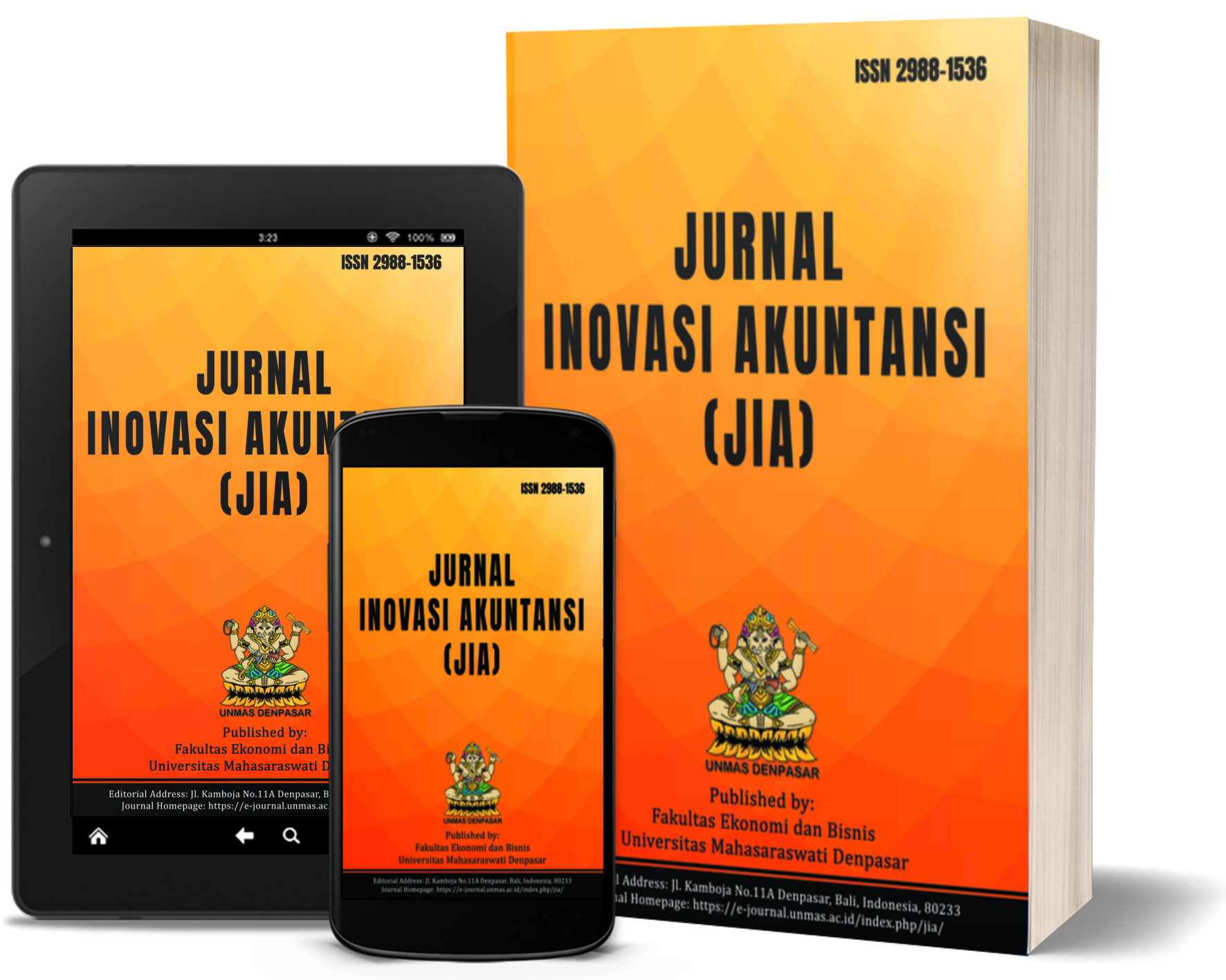Pengaruh Self Attribution Bias, Mental Accounting, Familiarity Bias dan Toleransi Risiko terhadap Pengambilan Keputusan Investasi
DOI:
https://doi.org/10.36733/jia.v3i1.10585Keywords:
Investment Decisions, Self Attribution Bias, Mental Accounting, Familiarity Bias, Risk ToleranceAbstract
The purpose of this study was to determine some of the effects of bias, namely self-attribution bias on investment decision making, mental accounting on investment decision making, familiarity bias on investment decision making, and risk tolerance on investment decision making. The theory used is behavioral finance theory and prospect theory. This study used a purposive sampling method in selecting the sample. The sample used was students who joined the capital market study group and an investor at Atma Jaya Makassar University in the 2019-2021 class. Data collection method is done through a questionnaire. The analysis technique used is multiple linear analysis. The results of this study indicate that self-attribution bias has a positive and significant influence on investment decision making, mental accounting has a positive and significant influence on investment decision making, familiarity bias has a positive and significant influence on investment decision making, and risk tolerance has a positive and significant influence on investment decision making.
References
Anggini, N. D., Wardoyo, C., & Wafaretta, d. V. (2020). Pengaruh Self-Attribution Bias, Mental Accounting, dan Familiarity Bias terhadap Pengambilan Keputusan Investasi Mahasiswa Akuntansi. Jurnal Penelitian Bisnis dan Investasi, Vol. 6, No. 3, Desember 2020.
Badriatin, T., Rinandiyana, L. R., & Marino, W. S. (2022). Persepsi Risiko dan SIkap Toleransi Risiko Terhadap Keputusan Investasi Mahasiswa. , Volume 20 No. 2 September 2022.
Bangun, V. L. (2020). Pengaruh Literasi Keuangan, Persepsi Risiko dan Overconfidence terhadap Keputusan Investasi. Skripsi. Fakultas Bisnis dan Ekonomika Universitas Islam Indonesia.
Brooks, M. (2008). Behavioral Finance: Theories and Evidence. The Research Foundation of CFA Institute.
Budiarto, A., & Susanti. (2017). Pengaruh Financial Literacy, Overconfidence, Regret Aversion Bias, dan Risk Tolerance Terhadap Keputusan Investasi. Jurnal Ilmu Manajemen, Vol 5, No 2.
Cremers, M., & Pareek, A. (2011). Can Overconfidence and Biased Self-Attribution Explain the Momentum, Reversal, and Share Issuance Anomalies? Evidence from Short-Term Institusional Investors. SSRN Electronic Journal.
Ghozali, I. (2012). Aplikasi Analisis Multivariate dengan Program IBM SPSS. Semarang: Badan Penerbit Universitas Diponegoro.
Halim, A. (2015). Analisis Investasi dan Aplikasinya. Jakarta: Salemba Empat.
Herlina, H., Winarto, B., & Suwarno. (2020). The Herding and Overconfidence Effect on the Decision of Individuals to Invest Stocks. In Journal of Economics and Business (Vol 3).
Holly, A., Jao, R., & Limang, A. (2022). Perilaku Bias Emosional dan Risk Tolerance dalam Pengambilan Keputusan Investasi . Muhammadiyah Riau Accounting and Business Journal, 4(1), 001-017. https://doi.org/10.37859/mrabj.v4i1.4036
Huberman, G. (2001). Familiarity Breeds Investment. The Review of Financial penelitianes, 14(3), 659-680.
Lararenjana, E. (2021, Desember). Mental Accounting adalah Sebuah Perilaku Ekonomi Individu. Retrieved from merdeka,com: https://www.merdeka.com/jatim/mental-accounting-adalah-sebuah-perilaku-ekonomi-individu-ini-selengkapnya-kln.html
Mahina, J. N., & Florence, M. (2018). Effect of Self-Attribution Bias in The Rwandan Stock Market. Global Journal of Management and Business Research.
Mishra, S. B. (2018). Behavioral Finance: Investor Self Attributi. Research Gate.
Mushinada, & Veluri. (2019). Elucidating Investors Rationality and Behavioural Biases in Indian Stock Market. Review of Behavioral Finance, 11(2), 201-219.
Nofsinger, J. R. (2001). The Impact of Public Information on Investors. Journal of Banking dan Finance.
Nofsinger, R. J., & Hirschey, M. (2008). Investment : Analysis and Behavioral. New York: McGrawHill.
Nuryassin, S. M., & Nurhadi, E. (2021). Pengaruh Literasi Keuangan dan Risk Tolerance Terhadap Keputusan Investasi Saham. Jurnal Sociaperti, Vol. 1, No. 1, Juni 2021.
Pompian, M. (2012). Behavioral Finance and Wealth Management. How To Build Investment Strategies That Account For Investor Biases. New York: John Wiley & Sohn, Inc.
Putra, A. M. (2018). Pengaruh Toleransi Risiko, Kepercayaan Diri dan Ketersediaan Modal Terhadap MInat Berwirausaha Orang Muda. Skripsi. Fakultas Ekonomi Universitas Sanata Dharma.
Ricciardi, V. (2008). The Psychology of Risk : The Vehavioral Finance Perspective. papers ssrn.
Ristanto, Y. (2020). Pengaruh Financial Literacy, Pengetahuan Investasi dan Pelatihan Pasar Modal Terhadap Keputusan Investasi Melalui Minat Investasi Sebagai Variabel Intervening. Undergraduate Thesis Universitas Negeri Semarang.
Shiu, C., & Hsu, Y. (2007). Investors’ Overconfidence in Primary Market. 20th Australasian Finance & Banking Conference 2007 Paper.
Sulphey, M. (2014). Behavioural Finance. Delhi: PHI Learning Private Limited.
Supramono, & Wandita, M. (2017). Confimation Bias, Self Attribution Bias, dan Overconfidence Dalam Transaksi Saham. Jurnal Keuangan dan Perbankan, 21(1):25-36, 2017.
Supriadi, A., Djuniardi, D., & Hamzah, A. (2022). Pengaruh Self attribution bias, mental accounting, familiarity bias, dan toleransi risiko terhadap pengambilan keputusan investasi (Penelitian Kasus Terhadap Korban Investasi Ilegal Binary Option. Journal of Global Business and Management Review.
Tandelilin. E. (2017). Portofolio dan Investasi. Jakarta: Pustaka Setia.
Thaler, R. (1985). Mental Accounting and Consumer Choice. Journal Marketing Science.
Wiryaningtyas, D. P. (2016). Behavioral Finance Dalam Pengambilan Keputusan. Proding Seminar Nasional.
Wulandari, D. A. (2014). Penelitian Experienced Regret, Risk Tolerance, Overconfidence, dan Risk Perception Pada Pengambilan Keputusan Investasi. Journal of Business and Banking.
Downloads
Published
How to Cite
Issue
Section
License
Copyright (c) 2025 Anthony Holly, Ana Mardiana, Robert Jao, Tripentita Loto Patandianan

This work is licensed under a Creative Commons Attribution 4.0 International License.








